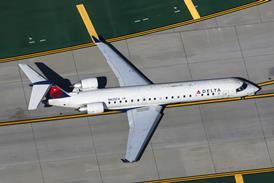In the byzantine world of the Russian aerospace industry, perhaps nothing should come as a surprise.The emergence, however, of Alexei Fedorov as Sukhoi's general director was an unexpected triumph for the boss of the Irkutsk Aviation Industrial Association.
Fedorov's ascension has come at the expense of Mikhail Simonov, the long-time eminence grise within Sukhoi, one of Russia's two premier combat-aircraft houses. The appointment has not been well received by Simonov, who remains reluctant to cede authority to his 20-years-younger rival.
Aviation Military Industrial Complex (AVPK) Sukhoi was set in motion by a presidential decree issued in August 1996, and finally set up with a Russian Government order on 30 December, 1996.
The five months between setting AVPK Sukhoi in motion and the Governmental order were characterised by politicking and jockeying for position as the incumbent, Simonov, and Fedorov lobbied for the support of the design and production organisations which were being brought into the new grouping.
AVPK Sukhoi combines two design bureaux, Sukhoi and Beriev, and three production plants: Komsomolsk-on-Amur, which produces Su-27 Flankers, Su-27K Flanker Ds, S-80 twin turboprop sand Be-103 light-utility amphibians; Novosibirsk, where Su-27IB strike developments of the Flanker and An-38 regional twin turboprops are made; and Fedorov's plant at Irkutsk, where Su-27UB Flanker Cs, Su-30 multi-role Su-27 derivatives and Be-200 amphibians are built.
New generation
Fedorov, like the managers moving into rival MAPO-MiG, belongs to a new generation of Russian industry captains. Having graduated from university at Irkutsk, he joined the IAPO Irkutsk production plant, rising to the position of general director. In the late 1980s he went to the USA to study business management at Oklahoma University.
The organisation which Fedorov will control has been set up by a Russian Government decree giving AVPKSuhkoi the status of a state enterprise, with state-owned KnAAPO of Komsomolsk and NAPO of Novosibirsk becoming its subsidiaries - and IAPOIrkutsk being partly privatised. This gives the central corporate office the power to hire or fire senior managers at subsidiary plants, although such decisions should also receive approval from the appropriate regional state administrations.
Fedorov's critics maintain that this management structure resurrects the style of the Soviet-era ministry of aircraft industry. Fedorov, unsurprisingly, disagrees.
"Since the collapse of the Soviet Union, when branch ministries disappeared, the very legislative basis of management has changed. The administrative procedure through orders and prescriptions of a general director has been substituted for a practice of contract agreements, so subsidiary enterprises and controlled public-owned companies delegate part of their management authority to the central corporate office, and that is fixed in the corporate charter. The subsequent management process goes through contract agreements," he explains.
"It is very important and, unfortunately, almost nobody, managers of subsidiary plants included, understands this change," complains the Sukhoi general director.
Recognising the difficulties in establishing the new corporate structure, Fedorov says: "Managers of subsidiary and subordinate enterprises fear that the general director may begin to flood them with orders to produce, or stop producing, this or that by a certain date. Nothing of this kind will happen."
Explaining the motives for establishing the new concern, Fedorov says: "Up until recently in Russia, the relationship between design bureaux and production plants differed radically from the rest of the world in their separation, even segregation, from each other. The absence of unified aircraft design and manufacturing companies hampers the competitive capabilities of our industry on the international, and now also on the domestic, market. The creation of AVPK Sukhoi is the second effort, after the establishment of VPK MAPO, to establish an integrated aerospace company in the internationally accepted meaning of this word".
As well as providing a structure to cater for "-a long-term strategy and planned research-and-development policy", Fedorov sees such companies as also addressing "the Achilles heel" of the Russian aerospace sector - post-"sales" maintenance. This, in part, caused by differing philosophies, has resulted in traditionally poor support.
According to Fedorov, the central corporate office will have a co-ordinating role primarily. There is no intention to duplicate all management functions of the member enterprises. Within this role he identifies the task of determining the direction of strategic R&D as the priority task.
Fedorov is trying to avoid confrontation with senior management within the various enterprises of AVPKSukhoi, although, inevitably, given their previous independence, friction is inevitable.
Horizontal integration
Simonov has not given up his fight against the Fedorov strategy, claiming that only with the supremacy of a design bureau and general designer can the Russian industry preserve its technological achievements and continue to be competitive. He continues to campaign actively for "horizontal rather than vertical integration", with considerable industrial and political support.
The second corporate priority defined by Fedorov is a unified technological and manufacturing policy. "Many enterprises have duplication of manufacturing processes. Some are designed uniquely for a certain plant, and this is not always done efficiently," he says .
Industrial co-operation between the three Sukhoi plants is another component of the corporate policy. So far, each of the plants has been largely independent, keeping all necessary manufacturing processes at each of the locations, a practice which results in high manufacturing expenses.
"Low production costs and low prices, our indisputable advantage of previous years, are rapidly dissipating, and we are approaching the world level of prices. It is high time to reconsider our operations on the basis of efficiency, lowering costs and non-productive expenses, and this can be done through deep industrial integration of the plants," says Fedorov.
Consolidation and concentration of financial resources, gained from export revenues from deliveries of Sukhoi and Beriev aircraft, should become another advantage of the new corporate structure.
"Today, dispersion of export revenues and the evident shortage of budget financing in general have paralysed work on strategically important research-and-development programmes, both at Sukhoi and Beriev design bureaux," warns Fedorov. "We must invest heavily n these advanced projects, in development of prototypes which would fly in ten to 20 years from now, but our desire to do that is not everything that is needed," he adds
Sukhoi plans to finance not only its own R&D programmes, but to invest in aviation scientific-research institutes, working on even more futuristic projects. Fedorov believes that such institutes as TsAGI (Central Aero-Hydrodynamics Institute), VIAM (All-Russia Institute of Aviation Materials) or LII (Flight Research Institute) should receive their financing from two sources - the state budget and contracts for research programmes from the leading aircraft manufacturers.
The Sukhoi general director is aware that, with the current status of the Russian economy and the state budget, the state defence order and the federal programme of civil-aviation development will make up a minority of AVPK Sukhoi's revenues, so it will have to rely mostly on export contracts during the next few years.
Even keeping the technological potential to develop advanced aircraft for the Russian military will in the near to medium term have to be predominantly self-financed.
Fedorov expresses his hopes for better days, saying: "In the future, when market conditions and budget financing change, we will re-orient ourselves towards our major customer, the ministry of defence, with great pleasure."
According to military planners, such a change may happen around the year 2005, when the Russian armed forces plan to re-arm themselves with new-generation weapons systems, pending recovery of the national economy.
Fedorov thinks that it is vital to keep the final-assembly ability of all three Sukhoi production plants. He is not ready, however, to comment on the distribution of production of Su-27 modifications between the units.
Now, each of the plants is producing at least one modification of the Sukhoi fighter.
Order distribution
"We will have to think very thoroughly how to distribute orders between the plants. Each of them has its own level of production cost and economical efficiency. Our task is to maximise the overall economical efficiency of the concern," says Fedorov.
Giving as an example the KnAAPO Komsomolsk plant, Fedorov comments that it is not feasible to transfer production of the Su-27K naval Flanker, or the single-seat multi-role fighter designated the Su-35 to anywhere else. Sukhoi will continue to invest its own money in development and testing of the Su-35, to develop a fighter suitable for export and for the Russian air force.
Fedorov is keen to see progress at the NAPO Novosibirsk plant, He says: "NAPO has two very interesting production programmes, the Sukhoi Su-34 and Antonov An-38, but it really suffers from a lack of orders and, subsequently, cashflow. It is very important to include Novosibirsk in fulfilling current export orders in which Komsomolsk and Irkutsk are involved, ensuring its workload and financing".
Source: Flight International























